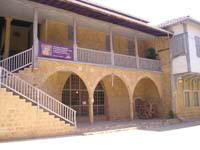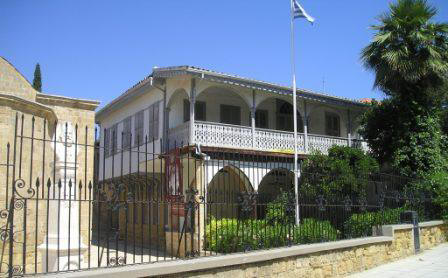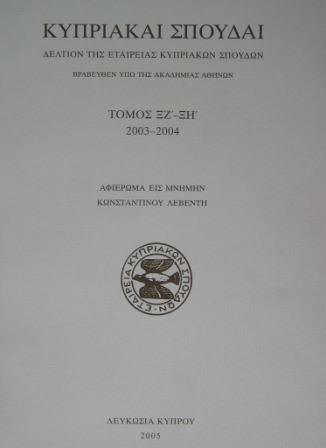|
|
..............................................................................................................
History of the Society
One of the oldest
active non-governmental associations in the wider Hellenic world, it
was founded during British rule in Cyprus by a small
 group
of Cypriot scientists. Its formation may be considered the Cypriots’
scientific riposte to the callous period of Palmer’s rule as
Governor (1933-1939) that followed the uprising of 1931; as a
reaction to the policy of de-hellenisation that the British
instituted at that time. The 24 founding members gathered at a
General Meeting on 17 April 1936 in the Nicosia Pancyprian
Gymnasium. They approved its constitution and elected the first
board of management, consisting of Constantinos Spyridakis as
president, Savva Christi vice-president, Achilleas Emilianides
secretary, Antonis Indianos treasurer and as members Nearchos
Clerides, George Papacharalambous and Costas Prousis. Presidents of
the Society have been: Constantinos Spyridakis (1936-1976); George
Papacharalambous (1976-1986); Kypros Chrysanthis (1986-1998); George
Ioannides (1998-1999) and Andreas Mitsides (1999-2006). group
of Cypriot scientists. Its formation may be considered the Cypriots’
scientific riposte to the callous period of Palmer’s rule as
Governor (1933-1939) that followed the uprising of 1931; as a
reaction to the policy of de-hellenisation that the British
instituted at that time. The 24 founding members gathered at a
General Meeting on 17 April 1936 in the Nicosia Pancyprian
Gymnasium. They approved its constitution and elected the first
board of management, consisting of Constantinos Spyridakis as
president, Savva Christi vice-president, Achilleas Emilianides
secretary, Antonis Indianos treasurer and as members Nearchos
Clerides, George Papacharalambous and Costas Prousis. Presidents of
the Society have been: Constantinos Spyridakis (1936-1976); George
Papacharalambous (1976-1986); Kypros Chrysanthis (1986-1998); George
Ioannides (1998-1999) and Andreas Mitsides (1999-2006).
The emblem of the
Society is an eagle with outspread wings taken from depictions on
ancient Cypriot coins. Around it is inscribed: “Society of Cypriot
Studies”.
The Society is housed
in the palace of the old Archbishopric that was offered to them for
this purpose by Archbishop Makarios II (1947-1950) and Makarios III
(1950-1977), of blessed memory.
The basic objectives
of the Society are the collection, preservation, study and
publication a) of the historical material related to all periods of
Cyprus History; b) of the linguistic material referring to the
history and evolution of the Cypriot dialect; c) of the folklore
material from all periods of Cyprus history and d) the collection of
works of Cypriot folk art and their preservation, study and
promotion.
The main activities
of the Society are:
-
The
annual publication of a scientific newsletter entitled “Cypriot
Studies”. To date 68 volumes have been put in circulation. In
this newsletter are published studies referring to the history,
archaeology, folklore, language, art, education of Cyprus, and
other related subjects. In 1946 it was awarded a prize by the
Athens Academy.
-
A series of independent publications
referring to aspects of Cyprus culture. Twelve of these have
been published so far. By way of indication we may refer to:
Angeliki Pieridou, Cypriot Folk Art, 1980; Andreas and
Judith Stylianou, 1971; Eleni Papademetriou, Ethnographics of
the Karpass, 1992; Margarita Demetriou, Shadow Theatre,
2004.
-
The founding of the Museum of Folk Art (1937). Here are displayed weaving, lace work, wood carvings,
and silverwork, basket-weaving and other artefacts from the
island’s folk art. The Museum is housed on the ground floor of
the old residence of the Archbishopric which was offered to the
Society for this purpose by Archbishop Makarios II (1947-1950),
of blessed memory. Most actively involved in the formation and
enrichment of the Folk Art Museum were Adiamantios Diamantis of
blessed memory and the folklorist Eleni Papademetriou.
-
The stocking of the library with books,
mainly of Cyprological subject matter, as well as with a number
of manuscripts.
-
The organisation of an International
Cyprological Conference, of which three have been held to date
(1969, 1982 and 1996) and whose minutes have been published. In
2008 it is expected that the fourth Cyprological Conference will
be take place on the 29 April.
-
The organisation of scientific lectures and
announcements concerning subjects related to Cyprus and her
culture.
For its activities
and contribution the Society of Cypriot Studies was honoured with a
prize by the Athens Academy on 24 March 1946. The main financial
supporters of the Society are the Archbishopric of Cyprus, the
Ministry of Education and Culture and the Cyprus Tourism
Organisation. There has been periodically some significant financial
support from Kykkos Monastery, the Leventis Foundation, the
Paraskevaides Foundation and others.
To become a member
download the form
and send it to our
address or email.
|